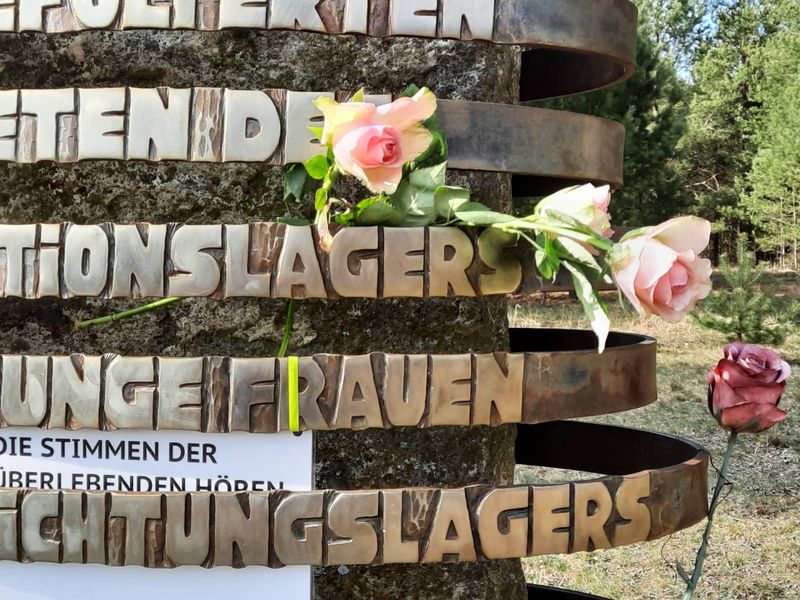History of the memorial site
After 1945
There are no documents or photos from the Nazi period concerning the topography of the concentration camp.
After the liberation of the camp in April 1945, the barracks were burned down due to a typhus epidemic and it was not used from that time on.
In 1952, graves located behind the Siemens barracks at the Uckermark concentration camp were reburied by order of the Brandenburg Ministry of the Interior and buried at the camp wall (now the Rose Bed).
In 1959, the Ravensbrück National Memorial was opened.
Integration into the Ravensbrück National Memorial was rejected by the responsible authorities in 1963. The site increasingly fell into disrepair until it was used and redeveloped by the Soviet military starting in the 1970s. In 1993/94, the CIS troops withdrew. There was hardly anything left to see of the former concentration camp.
In 1993, after the so-called reunification, the Ravensbrück Memorial would be opened. The Uckermark Concentration Camp Memorial was then, as now, not part of the Ravensbrück Memorial, nor was it included in the Brandenburg Memorials Foundation when it was established, and it still does not appear in its planning.
Memorial Site
It was not until 1995 that survivors, their families and friends managed to bring the site back into public discussion. The Lagergemeinschaft Ravensbrück/ Freundeskreis e.V. erected a plaque in memory of the prisoners of the youth concentration camp and later extermination site on the 50th anniversary of the liberation with the inscription: You are not forgotten.

The area was a deserted place until that time, it was littered with garbage, completely crammed by the armored halls of the Red Army (CIS – troops) and surrounded with fences. Only this small sign pointed to the former concentration camp.
The owner of the area at that time was the federal government, namely the Bundesanstalt für Immobilienangelegenheiten (BIMA).
In the summer of 1996, during a visit to the Ravensbrück Memorial, women* from the Lagergemeinschaft Ravensbrück/ Freundeskreis e.V. (Ravensbrück Camp Community/Friends’ Circle) were approached by a staff member. (LGRF) were asked by an employee of the Ravensbrück Memorial and Remembrance Center (MGR) whether they would be interested in conducting a construction camp on the grounds of the former youth concentration camp and later extermination site in Uckermark.
In 1997, the first excavations took place during a construction camp on the former concentration camp site and some foundations of the youth concentration camp were uncovered. In the same year, a landscape planning competition for the design of the entire site was announced by the city of Fürstenberg and the Ravensbrück Memorial. The 1st prize was won by a design that proposed a blue flower field as a memorial design for the former youth concentration camp. Excavations for historical research were planned for the later extermination site. The realization of this design as well as further research of the site was not carried out due to financial reasons and unresolved ownership issues.
In 2001, excavations were carried out for the 2nd time during a construction camp. These excavations prevented that a bypass road, which was in planning, was led over the area.
From 2001 onwards, construction and meeting camps were held annually at the memorial site. These construction camps bore different names and were held as WomenLesbians and, after much discussion and debate, as WomenLesbiansTransgender. At the present time they are advertised as feminist-antifascist construction camps.
In 2005 there was the first commemoration of the anniversary of liberation.
In 2008, the network launched the “100X100” campaign to raise funds for a memorial stone. In 2009, the memorial stone was erected. This memorial stone was designed by an artist/smith of the network and inaugurated during the commemoration ceremony . With the memorial stone, one of the greatest wishes of survivors has come true.
In 2012, after a long and tough struggle by many people, initiatives and the memorial, the military superstructures were dismantled (conversion) and the site was taken over by the state of Brandenburg.
The accessibility of the site was increased by this step.
Since 2020, a new exhibition in German and English has been on display at the memorial site.
These mentioned activities are not planned and carried out by the state, but by a network/initiative for a memorial site KZ Uckermark. The initiative works closely with the Lagergemeinschaft Ravensbrück/Freundeskreis. The cooperation with the Ravensbrück Memorial takes place on various occasions and is not always without conflict.
This network emerged in 2001 from the annual construction and encounter camps. Feminists and anti-fascists from various cities are organized in this network.

